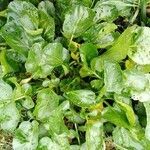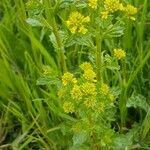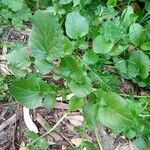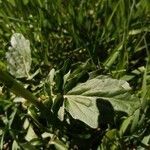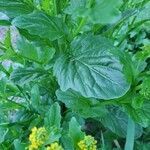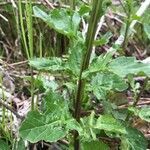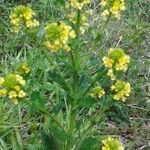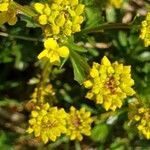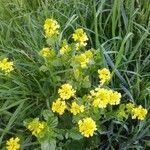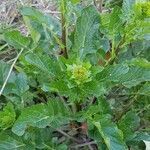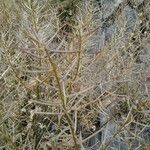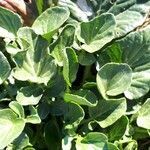Biennials or, rarely, perennials; glabrous throughout or margins ciliate. Stems (1.5-)2-9(-12) dm. Basal leaves: petiole (0.5-)2-10(-17) cm; blade lyrate-pinnatifid, (1-)2-8(-10) cm, lobes 1-3(-5) on each side (rarely early ones undivided), lateral lobes oblong or ovate, 0.3-2(-4) cm × 1-8(-15) mm, sometimes slightly fleshy, margins entire, repand, crenate, or dentate, terminal lobe (ovate or suborbicular), (0.7-)1.5-4.5(-7) cm × (4-)10-30(-50) mm, (surfaces glabrous or margins ciliate). Cauline leaves: blade ovate or suborbicular (undivided), margins usually coarsely dentate, rarely subentire; conspicuously auriculate, auricles ovate or narrowly oblong (to 10 × 5 mm), glabrous. Fruiting pedicels divaricate to ascending or erect, 3-7 mm, terete or subquadrangular, thickened (narrower than fruit). Flowers: sepals 3-4.5(-5) × 1-1.5 mm, lateral pair slightly saccate basally, margins scarious; petals yellow, spatulate or oblanceolate, (5-)6-9(-10) × 1.5-2.5(-3.5) mm, base attenuate, apex rounded; filaments 3-4.5 mm; anthers 0.7-1.2 mm; ovules 18-24(-28) per ovary; gynophore to 0.5 mm. Fruits erect to erect-ascending, rarely appressed to rachis, torulose, terete, somewhat compressed, or 4-angled, (0.7-)1.5-3 cm × 1.2-2 mm; style slender, (1-)1.5-3(-3.5) mm. Seeds dark brown, plump, broadly ovoid to oblong or subglobose, 1.2-1.5 × 1-1.2 mm. 2n = 16.
A cabbage family herb. It grows up to 80 cm tall. It completes its life cycle over 2 years or can grow for a few years. It has rings of dark glossy green leaves at the base. These have teeth around the edge. The stems are erect and have a few branches. The lower stem leaves are broadest just above the middle. They are 7-15 cm long and have deep lobes along the sides. They have leaf stalks. The leaves further up the stem are smaller and without stalks. The flowers are bright yellow. They occur in clusters in a cylinder shape. Each flower has 4 narrow yellow petals. The fruit pods are very narrow and 1.5-3 cm long. They have a short beak at the tip. The pods split open along their length to release the small seeds.
Dark green, erect, branched above, 2–8 dm, bitter; basal lvs petiolate, with 1–4 pairs of small, elliptic to ovate lateral lobes and a large, ovate to rotund terminal one; cauline lvs progressively reduced, the upper sessile and generally lobed rather than pinnatifid, or the uppermost entire or merely toothed; fls crowded at anthesis; pet 6–8 mm; mature pedicels 3–6 × 0.5 mm; frs erect and appressed to ascending or spreading, 1.5–3 cm, the beak 2–3 mm; 2n=16. Native of Eurasia, now widely naturalized as a weed in wet meadows and in damp soil of fields, roadsides, and gardens. Apr.–June. (B. barbarea; Campe b.; B. stricta; Campe s.)
Glabrous biennial to perennial. Stems branched above, 30-60-(100) cm tall. Rosette lvs lyrate-pinnate, (5)-10-20-(25) × 1-3-(4) mm; terminal lobe rounded-oblong; lateral lobes in (0)-1-3-(5) pairs, the distal pair > width of terminal lobe; margins toothed or sinuate. Upper stem lvs becoming simple, obovate or ovate, coarsely toothed. Racemes to 30 cm tall; pedicels erecto-patent to ± patent, 4-7 mm long. Sepals glabrous, 3-4 × 1-1.5 mm. Petals 5-6 × 1.5-2 mm. Silique erect, (15)-20-(30) × 1-1.5 mm; style 2-3 mm long.
